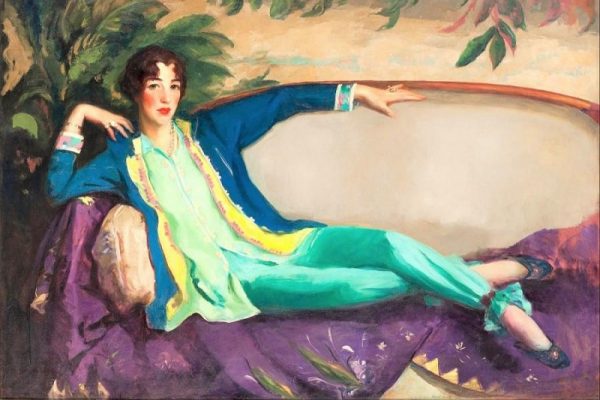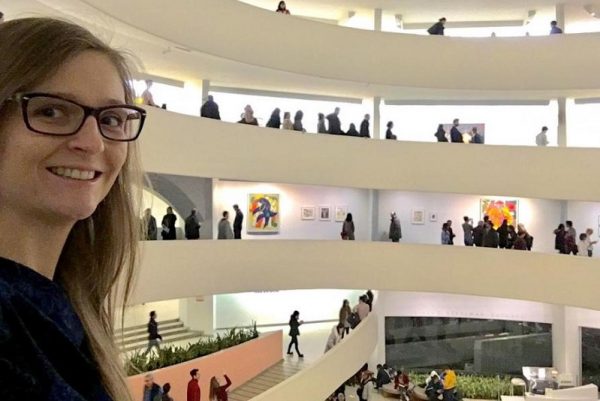| Maria Sztuka |
When asked about the leading figures of American culture, the names of representatives of abstract expressionism usually appear: Mark Rothko, Paul Jackson Pollock or the representative of pop art Andy Warhol. Popular associations usually do not go further than the mid-twentieth century, and only a small group of specialists have knowledge about nineteenth-century artists. One could therefore conclude that at the turn of the 19th and 20th centuries, i.e. at a time when Europe was teeming with life and belle époque became a synonym for an extraordinary flourishing of culture and art, not much was happening in the United States in the same period. According to Barbara Lewicka, PhD, assistant professor at the Institute of Sociology of the University of Silesia, this opinion is not only untrue but also unfair.
After the publication of the monograph “Necropolises. A sociological study of cemeteries in Katowice” (University of Silesia Press) in 2017, the sociologist focused her research interests on American culture from the perspective of the sociology of art. In 2020, the PWN Scientific Publishing House published a book entitled “Image and Society. The social framework of artistic culture”, whose authors are Barbara Lewicka, PhD and Prof. Marek S. Szczepański. The publication is a collection of reflections on the sociology of artistic culture. The authors focus on painting and film, assuming that these visual arts are an excellent starting point for sociological considerations.
–The book presents our passions. We devoted one of the essays to the painting of Edward Hopper, whose work began to flourish after 1920. Hopper was a student of Robert Henri. He was inspired by New York and the lives of its inhabitants. He showed their everyday life in modernist realities – loneliness, alienation, uncertainty. However, there would be no Hopper, if it were not for the earlier artists. His painting is a consequence of urban realism that arose at the turn of the century. According to cultural scientists (art historians share this opinion to a lesser extent), no one was as good at conveying the American spirit as Hopper.
At the next stage of making her passion a reality obtaining the Fulbright scholarship was a big help for B. Lewicka. In October 2019, at Columbia University in New York, the researcher began the implementation of the project entitled “American Symbolic Revolution. Art and Society”, whose primary goal was to reconstruct the character of the New York artistic milieu at the turn of the 19th and 20th centuries and to compare the nature of the changes in the American and European art world.
– An artist almost never functions alone – explains the sociologist. – A number of institutions are created around the artists, including academies, schools, galleries, museums, and auction houses. They are also accompanied by collectors, buyers and art dealers. A community of critics, reviewers, art historians, etc. is born. These entities create the world of art, in sociology we call it an artistic field. My intention is to reconstruct this world, recreate the relationship between individual elements, and illustrate their mutual interactions and connections. What is important to me is not only the artistic milieu, but also its relation with the environment, for example with the world of politics.
The end of the Civil War, i.e. 1865, is the starting point for research. A consequences of the painful experiences of war were social changes that had a significant impact on American art. There is an exceptional accumulation of activities, new institutions, schools, museums, galleries are established – units that had functioned in Europe much earlier. America is catching up. In the same year, Robert Henri was born, a realist painter, rebel against academism, leader of The Ashcan School, a new artistic movement in American painting. The date ending research explorations is marked by the beginning of the great economic crisis, i.e. 1929. The world of art, systematically built since the second half of the 19th century, is then destabilised, artists lose their income, many institutions collapse, and the collectors’ market collapses. In 1929, the charismatic Robert Henri also dies.
Robert Henri, “Gertrude Vanderbilt Whitney”, 1916 | public domain / Google Art. Project
When at the beginning of the 20th century Europe welcomes new styles: expressionism, futurism, fauvism, cubism, moving towards non-figurative art, the traditional historical style still reigns in the United States, which is persistently guarded by the New York Academy of Fine Arts founded in 1802. At the same time, Impressionism is well received in America.
– At the turn of the century, the United States was still bound by the principle of presenting a world that is beautiful, and even more beautiful than reality. The artists draw their themes mainly from nature, the city is rarely shown. If anything, a few impressionists deal with it. These painters took a liking for New York’s Upper East Side, inhabited by the financial elite. Its carefree world is shown by works from the end of the 19th century, which appeal to both the public and academic professors who successfully suppress attempts to break the dominant, idyllic aesthetics, eliminate opposing artists, and prevent them from participating in exhibitions and competitions. The Academy is an oracle and a censor. Artists cannot paint what is considered immoral, especially nudity. According to federal law, exposures of nudes are intercepted and “arrested” – explains the sociologist.
The first decade of the twentieth century brings the independence of the creators, more and more often they decide for themselves what is and what is not art. New trends are emerging, including the enthusiastically received urban realism focusing on the lives of poor New Yorkers.
– It was the beginning of changes – the researcher says. – Idyll is being replaced by paintings depicting ugliness, poverty, and neglected areas of the city. Artists gathered around Robert Henri remain faithful to the traditional technique to some extent, but they search for themes in the Lower East Side, i.e. the poorest, emigrant district. The academy rejects their works; Henri leaves the academy and creates an independent exhibition of unwanted works. This turns out to be a success, and painters are from now one called revolutionaries. The Ashcan movement is born.
In 1913, thanks to the Armory Show – the International Exhibition of Modern Art – America gets to know the avant-garde works of Pablo Picasso or Marcel Duchamp. Is is a beginning of modernism in the United States. The conservative realists of The Ashcan School take a back seat.
The main place of research for Lewicka was Columbia University, which has the largest library of art history in the United States. The researcher used catalogues from exhibitions, press materials, correspondence between artists and institutions, notes from art dealers, and notes from exhibitions. There is also a rich collection of personal documents in the New York Public Library. Another treasury of knowledge for scientists from around the world is the Frick Collection – a museum and at the same time a leading centre for art research. The sociologist also used the resources of the Museum of Modern Art and the Whitney Museum of American Art devoted to American art. The exploration of libraries, museums and galleries was supplemented by walks in the footsteps of New York painters, which allowed the researcher to confront the spaces preserved by artists with their contemporary shape.
Research on multiculturalism in New York has revealed surprising connections between individual social actors: artists and collectors, politicians, and social activists. The creators kept in touch with both representatives of the establishment and American dissidents, and immortalized them on their canvases. This diversity is perfectly reflected by Robert Henri, who portrayed Emma Goldman, a famous anarchist, but also Gertrude Whitney, an aristocrat from one of the wealthiest American families – the Vanderbilt, sculptor and art collector.
It turns out that American painters owe a lot to women. In the nineteenth century, art was collected by men who, guided by mercantile reasons, invested capital in the works of the most eminent European artists (hence the United States has such an impressive collection). At the beginning of the 20th century, the emancipated wives of the rich also began to collect art, but with much more modest resources, they invested in native artists. Gertrude Whitney became a patron of the arts and organized exhibitions of promising artists. She was also an outstanding sculptor, known e.g. from the monumental sculpture of the Titanic Memorial. In 1931, she founded the Whitney Museum of American Art. New York’s first museum of contemporary art, the Museum of Modern Art (MoMA), is also the work of three women led by Abigail Rockefeller.
The research will be continued by the sociologist thanks to the Research Excellence Initiative launched at the University of Silesia and co-financing from the “Freedom of research” programme. This time, she will conduct a query at the Terra Foundation for American Art in Paris, where the largest library of American art in Europe is located. While art historians, cultural scientists, literary scholars and Americanists have subjected the period of the turn of the century in the United States to a detailed research analysis, there have been no studies from a sociological perspective so far. This gap will probably be filled by a monograph prepared by B. Lewicka, PhD.
The article entitled “The world of New York art at the turn of the 20th century” was published in the June issue of Gazeta Uniwersytecka UŚ (University of Silesia Magazine) no. 9 (289).
Barbara Lewicka, PhD at the Guggenheim Museum in New York | photo from the archive of B. Lewicka, PhD







